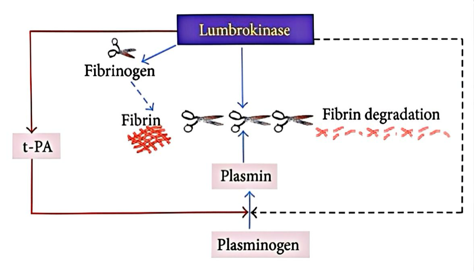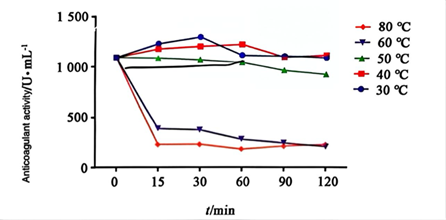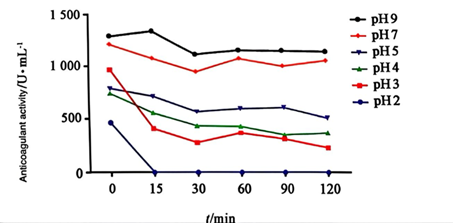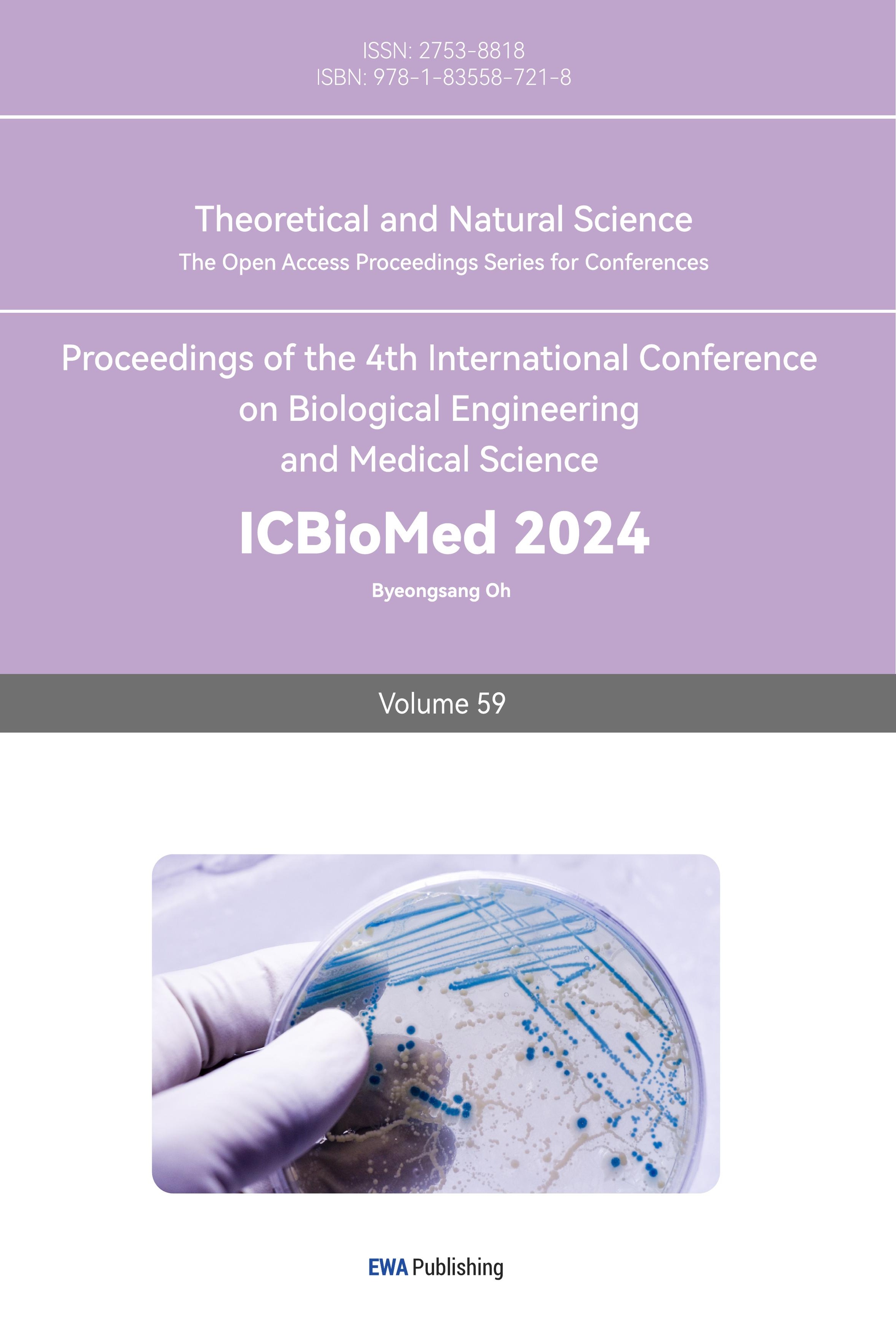1. Introduction
Nowadays, due to changes in people’s dietary structure and labor ratio, cardiovascular diseases such as heart failure, stroke, and rheumatic heart disease are becoming more and more common [1]. Pathological thrombosis is the main cause of these cardiovascular diseases, and antithrombotic therapy has become the main treatment for cardiovascular diseases. On the damaged atherosclerotic plaques, aggregated platelets and a large amount of fibrin form thrombi that trigger ischemic cardiovascular disease attacks [2]. Long-term antiplatelet monotherapy based on acetylsalicylic acid (aspirin, ASA) [3] increases the risk of gastrointestinal bleeding complications [4,5]. Therefore, when looking for alternative ASA drugs, it was found that lumbrokinase isolated and purified from earthworms can not only directly dissolve fibrin into soluble peptides, but also reduce platelet adhesion and aggregation rates and inhibit platelet aggregation [6]. Compared with similar drugs such as urokinase and streptokinase, lumbrokinase does not have obvious side effects such as severe bleeding caused by urokinase and streptokinase due to non-fibrin-specific properties. Lumbrokinase has high safety and also has a large amount of raw materials with low production costs.
When lumbrokinase is used for human treatment, there are three treatment methods: oral, injection and enteric-coated tablets. As an oral agent, lumbrokinase is sensitive to pH and will be destroyed in gastric acid, which reduces the efficacy of lumbrokinase. When using injections, lumbrokinase is an exogenous protein, and its antigenicity and immunogenicity can easily cause allergic reactions in the human body. Enteric-coated capsules reduce immunogenicity and maintain its biological activity. In recent years, the rise of new drug systems has provided new ideas for the use of lumbrokinase. In order to improve the efficacy of lumbrokinase and reduce its immunogenicity, lumbrokinase is combined with new drug delivery systems, including nanoparticles, liposomes, etc., to protect the drug from damage in the body environment and improve targeting and bioavailability.
2. The mechanism of action of lumbrokinase
Dissolves fibrin and fibrinogen directly; Converts plasminogen to plasmin; Enhances endogenous tissue plasminogen activator (t-PA) [7].

Figure 1. Lumbrokinase Mechanism of Action [8].
(1) As shown in Figure 1, lumbrokinase has a special affinity for fibrin. It not only hydrolyzes fibrin rich in plasminogen, but also hydrolyzes fibrin that does not contain plasminogen, causing fibrin to degrade rapidly without causing excessive bleeding [8].
(2) Lumbrokinase can hydrolyze fibrinogen. It can also indirectly activate plasminogen to form plasmin, while stimulating vascular endothelial cells to release tissue-type plasminogen activator (t-PA), enhancing t-PA activity, converting plasminogen into plasmin [7,8], and hydrolyzing coagulation factor 1, inhibiting platelet aggregation [9].
(3) Lumbrokinase can increase cyclic adenosine monophosphate levels and reduce calcium release, while inhibiting the expression of intercellular adhesion molecule-1 (ICAM-1) to exert an anti-thrombotic effect [10].
3. Effects of external conditions on lumbrokinase
3.1. Temperature

Figure 2. Effect of temperature on the time-dependent changes in the anticoagulant activity of Pheretima philoxeroides PvQ [11].
As shown in Figure 2, PvQ loses its activity rapidly at ≥60°C; at 50°C, the activity remains basically unchanged within 60 min, and decreases slightly with time; when <50°C, the activity of the sample is less affected within 120 min. In addition, the anticoagulant activity of the sample increased during a short incubation period (0-30, 0-60 min) at 30-40°C compared to room temperature.
3.2. PH

Figure 3. Effect of pH on the time-dependent changes in the anticoagulant activity of Pheretimaphiloxeroides [11].
As shown in Figure 3, at pH=2, the anticoagulant activity of PvQ was lost sharply within 15 min of incubation; when pH was 3-5, the anticoagulant activity of PvQ dropped sharply within 30 min of incubation, and the activity remained at a weak anticoagulant level after 30 min; when pH ≥ 7, the anticoagulant activity of PvQ did not change significantly after 120 min of incubation. In addition, the anticoagulant activity of PvQ at pH 9 was slightly stronger than that at pH = 7, and it was speculated that the increase in the anticoagulant activity of PvQ may be related to its optimal reaction pH. It can be concluded that this type of protease is more active under alkaline conditions and severely inactivated under strong acid conditions.
In summary, temperature and pH have a great influence on the activity of lumbrokinase, and for temperature, human body temperature is in its optimal range. From the optimal pH range, it can be seen that lumbrokinase is more active under alkaline conditions and severely inactivated under strong acid conditions. It can be inferred that lumbrokinase is severely inactivated in gastric acid, while the colon is alkaline, under which conditions, lumbrokinase has strong activity. Therefore, enteric-coated capsules can retain the biological activity of lumbrokinase to the greatest extent.
4. Dosage forms
To avoid the effects of temperature and pH on the anticoagulant activity of lumbrokinase, people use the following two methods to administer the drug.
4.1. Injection
Lumbrokinase for injection has the effects of reducing fibrin and inhibiting platelet aggregation, and its effects are fast-acting, making it suitable for clinical emergency use. It can also act on the endogenous coagulation system at the same time, and can play a thrombolytic role in a short period of time. Because lumbrokinase is a foreign protein to the human body, it will be antigenic and immunogenic and prone to allergic reactions even if the purity meets the requirements.
4.2. Oral enteric-coated tablets
Studies have shown that after oral administration of lumbrokinase, the stomach and duodenum are its main absorption sites, and the colon has the strongest transport capacity. About 10% of the intact active enzyme molecules enter the blood through the intestinal epithelium in a special way and maintain their biological activity [12]. Colonic administration is beneficial to improving the stability and absorption of the drug in the gastrointestinal tract, which supports the rationality of oral enteric-coated dosage forms [13].
5. Drug delivery system-targeted delivery of platelet membrane functionalized nanoparticles
At present, nano drug delivery carriers such as liposomes, polymer micelles, and nanoparticles are widely used in clinical practice. However, they have problems such as poor targeting, short blood circulation half-life, and low bioavailability.
5.1. Platelet membrane extraction method
Since the first successful report of red blood cell membrane-encapsulated nanocarriers in 2011, many researchers have developed PLM-encapsulated nanocarriers. Platelets are separated and purified from fresh blood, and PLM is prepared by repeated freeze-thaw or hypotonic swelling. Nanocarriers are encapsulated in PLM by electrostatic adsorption, ultrasound or extrusion [14].
5.2. Causes of platelet thrombosis
Platelet thrombus is mainly composed of platelets and a small amount of cellulose, also known as white thrombus or precipitation thrombus. When the blood vessel is injured, when the subendothelial matrix such as collagen is exposed to the site of vascular injury, von Willebrand factor (VWF) will immediately adhere to it. At the same time, platelets begin to interact with the fixed VWF through the platelet membrane glycoprotein GPⅠβ molecule and activate the platelet inside-out signaling pathway, resulting in changes in the molecular structure of the platelet membrane glycoprotein GPⅡβ/Ⅲα. GPⅡβ/Ⅲ α molecules can specifically recognize the arginine - glycine - aspartic acid (RGD) sequence present in fibrinogen or VWF. This interaction causes platelets to aggregate with each other to form the initial platelet thrombus. The principle of platelet thrombus formation directly illustrates the natural targeting of platelets. This interaction causes platelets to aggregate with each other to form the initial platelet thrombus. The principle of platelet thrombus formation directly illustrates the natural targeting of platelets.
5.3. Advantages of Platelet Membrane Transport
PLT is an intrinsic component of the body’s circulatory system. It is an anuclear fragment produced by the lysis of mature megakaryocytes. It contains a variety of membrane proteins, such as CD47, which is involved in immune escape, CD55 and CD59, which inhibit complement activation, etc. It can reduce the clearance of drug delivery systems by the immune system and improve their biocompatibility and circulation half-life. It is involved in a variety of physiological and pathological activities including hemostasis, thrombosis and tumor metastasis [15]. PLT’s complex membrane protein receptor, on the one hand, as a self-protein, can escape the recognition and clearance of the immune system; on the other hand, it mediates the interaction between PLT and tumors, thrombi and pathogen infection sites, providing conditions for PLT -based drug delivery systems.

Figure 4. Schematic diagram of platelet membrane nanoparticles [16].
Based on the natural targeting of platelets to damaged blood vessels and thrombi, the challenge of connecting targeting groups to thrombolytic drugs can be avoided. Compared with existing molecular targeted thrombolytic drugs or thrombolytic therapies based on red blood cells, platelets have been widely studied and applied to the treatment of damaged blood vessels and thrombi in order to achieve higher drug targeting delivery efficiency and lower off-target side effects. As shown in Figure 4, Wang et al. developed a platelet membrane-coated poly (lactic-co-glycolic acid), PLGA] loaded with the thrombolytic drug lumbrokinase. In the mouse carotid artery model, it has higher targeting and better thrombolytic effect on thrombi than free lumbrokinase, and has fewer side effects on the coagulation system, reducing the risk of bleeding. This provides a promising means for platelet nano drug delivery systems to treat damaged blood vessels and anti-thrombotic treatments, which can effectively deliver drugs to the target site and prolong their circulation time in the body.
Compared with existing molecular targeted thrombolytic drugs or nanotherapy, this platelet-based drug delivery method can improve the stability and targeting of drug delivery carriers, improve drug efficacy, reduce drug off-target toxicity, prolong drug half-life, and has good in vivo pharmacokinetic properties, which may completely change the traditional administration route of anti-thrombotic drugs. Although this application has great advantages in theory, it still lacks relevant clinical applications and experience, and requires a large number of clinical trials to ensure its effectiveness and safety, and to prove the clinical feasibility of combining this new transport system with traditional effective substances.
6. Conclusion
This article discusses the mechanism of action of lumbrokinase and the influence of external factors on the activity of lumbrokinase, and explains the advantages and disadvantages of three traditional drug delivery methods: the earliest oral preparation can also play a certain role and is directly absorbed in the form of molecules in the intestine, but it will lose most of its activity in gastric acid before entering the colon. So people thought of the method of direct injection, making lumbrokinase into an injection, which is fast-acting, but because lumbrokinase is an exogenous protein to the human body and has immunogenicity, the human body is prone to allergic reactions after secondary contact. Later, lumbrokinase was made into enteric-coated capsules to retain the biological activity of lumbrokinase to the greatest extent and reduce its immunogenicity. Later, inspired by the new drug delivery system, the platelet membrane was combined with lumbrokinase to form a more efficient and safe drug delivery method, which uses the original targeting and stability of the platelet membrane to obtain a better thrombolytic effect. However, although there are such theoretical studies and a small number of animal model experiments, there is still a lack of research on the specific molecular mechanism of action of lumbrokinase, pharmacokinetic and pharmacodynamic studies, etc., and there is a big gap. Based on the basic mechanism of action of lumbrokinase, this article integrates the administration methods of traditional and new drug delivery systems with platelet membrane as carriers, providing a basic framework and direction for subsequent research. The carriers of the new drug delivery system are not limited to platelet membranes. Other carriers are not elaborated in this article. The different effects of different carriers can also be the direction of subsequent research. Future related research is expected to start from the molecular mechanism of action, pharmacokinetics and pharmacodynamics of lumbrokinase, and conduct a large number of clinical trials to obtain relevant potential side effects and give corresponding optimization and improvement. In subsequent production, standardized production can be used to ensure the activity of drug ingredients and the quality of drugs.
References
[1]. Amini M Zayeri F & Saleh M 2017 Trend analysis of cardiovascular disease mortality incidence and mortality-to-incidence ratio: Results from global burden of disease study
[2]. Asada Y Yamashita A Sato Y & Hatakeyama K 2018 Thrombus formation and propagation in the onset of cardiovascular events J Atheroscler Thromb 25 8 653-664
[3]. Mancia G Fagard R Narkiewicz K et al 2013 ESH/ESC guidelines for the management of arterial hypertension: The task force for the management of arterial hypertension of the European Society of Hypertension ESH and of the European Society of Cardiology ESC
[4]. Piepoli M F Hoes A W Agewall S et al 2016 European guidelines on cardiovascular disease prevention in clinical practice
[5]. Capodanno D Mehran R Valgimigli M et al 2018 Aspirin-free strategies in cardiovascular disease and cardioembolic stroke prevention
[6]. Wang X Hao L & Li H 2001 Observations on the efficacy of earthworm fibrinolytic enzyme and aspirin in treating hyperfibrinogenemia Chin J Integr Tradit West Med 17 72 95
[7]. Wang C Zhang H & Wang Y 2010 Advances in the study of earthworm fibrinolytic enzyme Med J Shenyang Mil Reg 23 3 201
[8]. Fan Q Wu C Li L Fan R Wu C Hou Q & He R 2001 Some features of intestinal absorption of intact fibrinolytic enzyme III-1 from Lumbricus rubellus Biochim Biophys Acta 1526 3 286-292
[9]. Wang X Zhang Y Pan R & He R 2010 Characteristics of transport and distribution of orally administered earthworm fibrinolytic enzyme in the gastrointestinal tract of rats Chin J New Drugs 15 1360-1364
[10]. You X Zhu K Liu J et al 2023 Research progress on drug delivery systems based on platelets and their derivatives Chin J Blood Transfus 36 11 1068-1073
[11]. Gay L J & Fielding-Habermann B 2011 Contribution of platelets to tumor metastasis Nat Rev Cancer 11 2 123-134
[12]. Wang S Wang R Meng N et al 2020 Platelet membrane-functionalized nanoparticles with improved targeting ability and lower hemorrhagic risk for thrombolysis therapy J Control Release 328 78-86
[13]. Kolas M Kumar P Choonara Y E et al 2019 Hypothesis: Can drug-loaded platelets be used as delivery vehicles for blood-brain barrier penetration? Med Hypotheses 125 75-78
[14]. Chen Y X Wei C X Lyu Y Q et al 2020 Biomimetic drug-delivery systems for the management of brain diseases Biomater Sci 8 4 1073-1088
[15]. Zhu C Ma J Ji Z et al 2021 Recent advances of cell membrane coated nanoparticles in treating cardiovascular disorders Molecules 26 11 3428
[16]. Li S Zhang K Ma Z et al 2022 Biomimetic nanoplatelets to target delivery hirudin for site-specific photothermal photodynamic thrombolysis and preventing venous thrombus formation Small 18 51 e2203184
Cite this article
Xie,Y. (2024). The anticoagulant ability of lumbrokinase and the advantages of different dosage forms. Theoretical and Natural Science,59,45-50.
Data availability
The datasets used and/or analyzed during the current study will be available from the authors upon reasonable request.
Disclaimer/Publisher's Note
The statements, opinions and data contained in all publications are solely those of the individual author(s) and contributor(s) and not of EWA Publishing and/or the editor(s). EWA Publishing and/or the editor(s) disclaim responsibility for any injury to people or property resulting from any ideas, methods, instructions or products referred to in the content.
About volume
Volume title: Proceedings of the 4th International Conference on Biological Engineering and Medical Science
© 2024 by the author(s). Licensee EWA Publishing, Oxford, UK. This article is an open access article distributed under the terms and
conditions of the Creative Commons Attribution (CC BY) license. Authors who
publish this series agree to the following terms:
1. Authors retain copyright and grant the series right of first publication with the work simultaneously licensed under a Creative Commons
Attribution License that allows others to share the work with an acknowledgment of the work's authorship and initial publication in this
series.
2. Authors are able to enter into separate, additional contractual arrangements for the non-exclusive distribution of the series's published
version of the work (e.g., post it to an institutional repository or publish it in a book), with an acknowledgment of its initial
publication in this series.
3. Authors are permitted and encouraged to post their work online (e.g., in institutional repositories or on their website) prior to and
during the submission process, as it can lead to productive exchanges, as well as earlier and greater citation of published work (See
Open access policy for details).
References
[1]. Amini M Zayeri F & Saleh M 2017 Trend analysis of cardiovascular disease mortality incidence and mortality-to-incidence ratio: Results from global burden of disease study
[2]. Asada Y Yamashita A Sato Y & Hatakeyama K 2018 Thrombus formation and propagation in the onset of cardiovascular events J Atheroscler Thromb 25 8 653-664
[3]. Mancia G Fagard R Narkiewicz K et al 2013 ESH/ESC guidelines for the management of arterial hypertension: The task force for the management of arterial hypertension of the European Society of Hypertension ESH and of the European Society of Cardiology ESC
[4]. Piepoli M F Hoes A W Agewall S et al 2016 European guidelines on cardiovascular disease prevention in clinical practice
[5]. Capodanno D Mehran R Valgimigli M et al 2018 Aspirin-free strategies in cardiovascular disease and cardioembolic stroke prevention
[6]. Wang X Hao L & Li H 2001 Observations on the efficacy of earthworm fibrinolytic enzyme and aspirin in treating hyperfibrinogenemia Chin J Integr Tradit West Med 17 72 95
[7]. Wang C Zhang H & Wang Y 2010 Advances in the study of earthworm fibrinolytic enzyme Med J Shenyang Mil Reg 23 3 201
[8]. Fan Q Wu C Li L Fan R Wu C Hou Q & He R 2001 Some features of intestinal absorption of intact fibrinolytic enzyme III-1 from Lumbricus rubellus Biochim Biophys Acta 1526 3 286-292
[9]. Wang X Zhang Y Pan R & He R 2010 Characteristics of transport and distribution of orally administered earthworm fibrinolytic enzyme in the gastrointestinal tract of rats Chin J New Drugs 15 1360-1364
[10]. You X Zhu K Liu J et al 2023 Research progress on drug delivery systems based on platelets and their derivatives Chin J Blood Transfus 36 11 1068-1073
[11]. Gay L J & Fielding-Habermann B 2011 Contribution of platelets to tumor metastasis Nat Rev Cancer 11 2 123-134
[12]. Wang S Wang R Meng N et al 2020 Platelet membrane-functionalized nanoparticles with improved targeting ability and lower hemorrhagic risk for thrombolysis therapy J Control Release 328 78-86
[13]. Kolas M Kumar P Choonara Y E et al 2019 Hypothesis: Can drug-loaded platelets be used as delivery vehicles for blood-brain barrier penetration? Med Hypotheses 125 75-78
[14]. Chen Y X Wei C X Lyu Y Q et al 2020 Biomimetic drug-delivery systems for the management of brain diseases Biomater Sci 8 4 1073-1088
[15]. Zhu C Ma J Ji Z et al 2021 Recent advances of cell membrane coated nanoparticles in treating cardiovascular disorders Molecules 26 11 3428
[16]. Li S Zhang K Ma Z et al 2022 Biomimetic nanoplatelets to target delivery hirudin for site-specific photothermal photodynamic thrombolysis and preventing venous thrombus formation Small 18 51 e2203184









